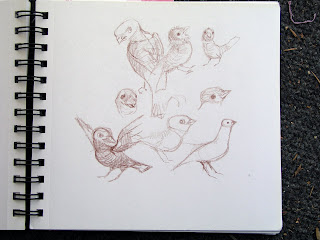

One of the first signs you are making progress is that moment when you have been drawing and drawing and begin to wonder,"where is this going?"



“The ‘Look’ of Sketchbooks”
Sketchbooks come in all kinds of flavors. Art Supply companies treat us to a new variety every season.
Here is what counts--archival paper ( meaning it is acid free and will not turn brittle and yellow over time) and that the book will lay flat when opened.
You may want a tiny one, exchanging the ease of tucking it in a pocket for the extra size and several more pages in a larger book. That results in needing to buy a succession of books. Keep them dated or numbered, Ok?
Expensive bindings and beautiful paper may inspire you. Or, inhibit. Sometimes noting that I am about to lay an ink line down on a fabulous surface just stops me cold.
Medium sized and medium priced books are functional. I use the pocket size when I go out and the larger ones at home.
Some artists want a foldout book. It acts as an ongoing story, which, like a Chinese scroll painting tells about an adventure.
For the beginner, focusing your attention is helpful. You might want boundaries rather than the unfolding, open-ended story. Try making little square or rectangular “boxes” to a page. Practice working within confined shapes. Let the limits sharpen you sense of composition and design. You can always scrawl all over the next page. It is your book. It is to learn with and for play.
 I use a ball point pen a lot. With pencil, you can erase, but I always lose my eraser. Pencil art really shoould be given a light coating of workable spray-fix.
I use a ball point pen a lot. With pencil, you can erase, but I always lose my eraser. Pencil art really shoould be given a light coating of workable spray-fix.